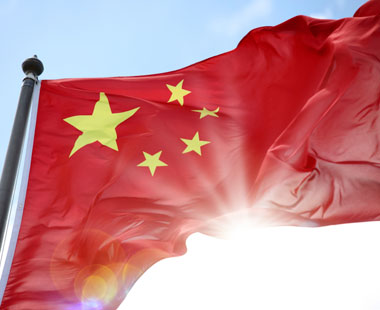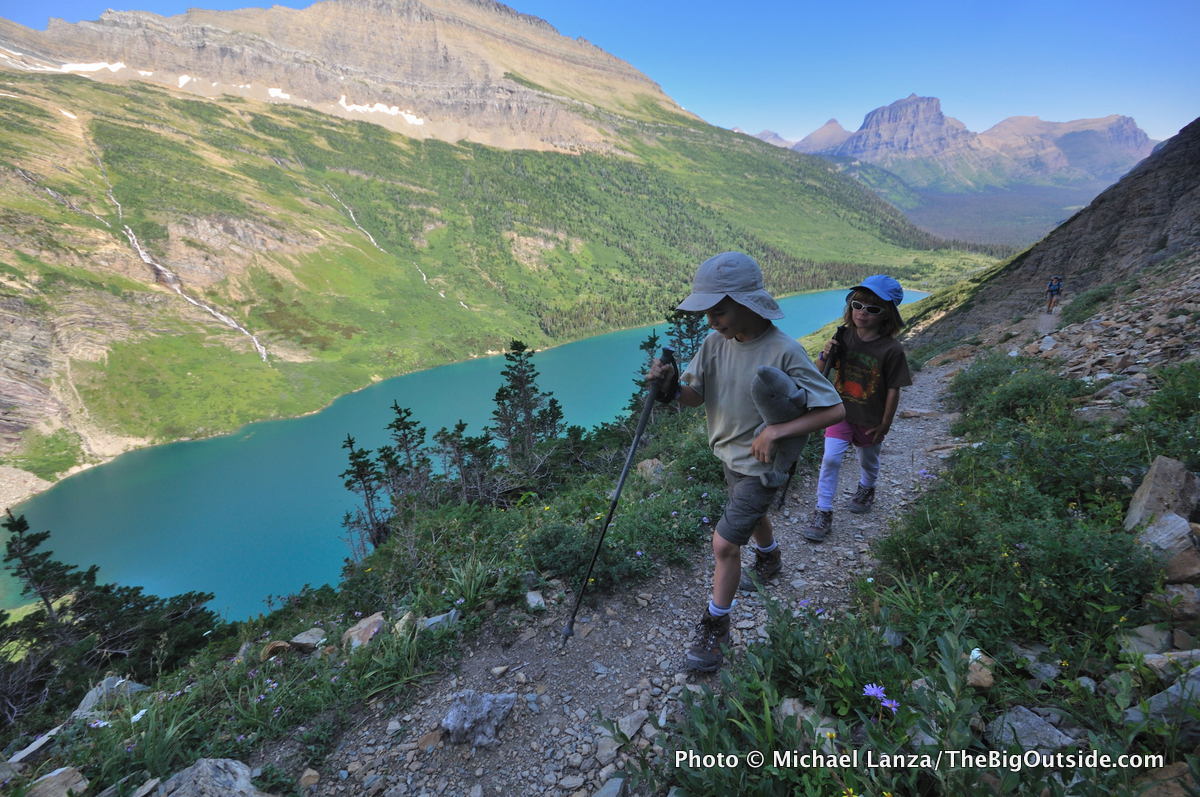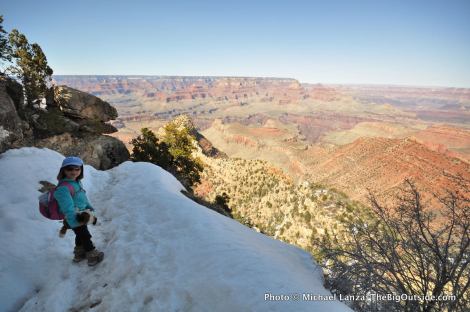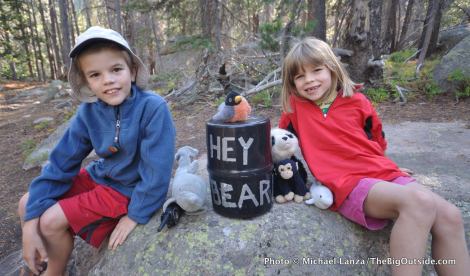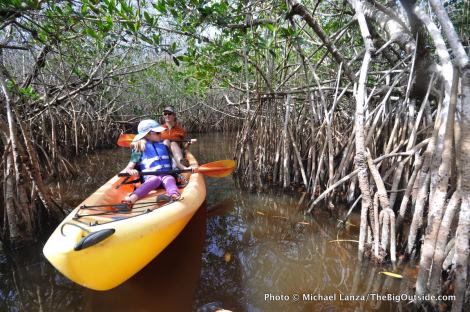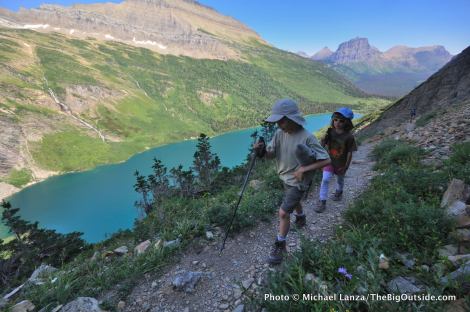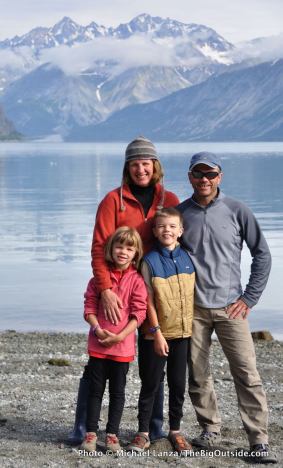When writer and outdoorsman Mike Lanza realized climate change was staking a full-scale assault on our most beloved national parks, he didn’t just lament about how his kids wouldn’t get to experience them the way he did. Instead, he saddled up his entire family — wife Penny, son Nate, 10, and daughter Alex, 7 — with packs, kayaks, and climbing gear and embarked on a year-long mission to visit them all. His new book Before They’re Gone: A Family’s Year-Long Quest to explore America’s Most Endangered National Parks chronicles the adventure. He took some time to answer a few questions about our changing parks, life-list trip planning, and educating the next generation about climate change through adventures in the great outdoors.
Q. What moment did the idea to take your kids out for this book hit you?
A. I had been researching and writing stories about the impacts of climate change on national parks and wilderness, and increasingly understanding that much of this fallout will occur within my kids’ lifetimes. But in September 2009, I returned to Glacier National Park to backpack for six days and met briefly with a leading federal scientist there, Dan Fagre, whom I had interviewed two years earlier for a story about the park’s glaciers. At that time, his models forecasted the glaciers in the park all disappearing by 2030. When I spoke with him again in 2009, he said they had revised that previous forecast because warming and glacial recession had sped up faster than anticipated: The projected year for no more glaciers in Glacier National Park was now 2020. I thought, Wow, my kids will be just 19 and 17 then. This is not far off in the future — it’s right around the corner.
I started thinking more and more in the fall of 2009 that we should get the kids to these places that mean so much to my wife and me as soon as we can. It wasn’t as if glaciers were going to disappear the next year. But it’s easy to get caught up in life and not achieve the goals you set, not see the places you want to see. I’ve long believed that you have to just have to get out and do things because you never know what’s in store for the future.
Q. A lot of people would love to do something like this, but they couldn’t ever dream of pulling it off. How’d you do it? What were the biggest logistical hurdles?
A. Part of the answer is that this is what I do for work. But I did this even years ago, before I made a living at it. Planning 11 major trips in a year’s time is definitely a lot of work. I researched where to go, reserved permits, arranged travel (some trips involved flights and lodging), packed and sorted and dried out and repacked gear numerous times, wrote hundreds of emails to outfitters and other people in the know, and figured out where to shoehorn each trip into the calendar. We made six of the 11 trips between late June and late August 2010; we weren’t at home very much that summer, and that alone can get tiring. In the busy lives that most people lead, to do things like this you have to plan months in advance and put dates on the calendar, or it’ll never happen.
But that said, we don’t look back on that year and think about the hassle of trip planning and travel. We think back on all the amazing experiences we had and the places we saw. At one point during our last trip for this book, canoeing in the Ten Thousand Islands of Everglades National Park, right after my son, who had turned 10 by then, and I had sat in our canoe watching a dolphin swim laps around a small bay for about 20 minutes, he said to me, totally unprompted: “You know, Dad, thinking back on this past year, and all the trips we’ve done, I think it might be my best year ever.”
My kids gleaned a rare kind of perspective from this experience that I believe will guide them for the rest of their lives.
Q. Were you worried for your kids? How did you deal with issues of safety?
A. I think it’s natural for any parent to worry more than necessary and it’s probably impossible to cure yourself of worrying. Penny and I had long, serious conversations about the wisdom of taking young kids backpacking in grizzly country; or sea kayaking in waters patrolled by orcas, where capsizing could mean dying of hypothermia within 15 minutes; paddling among alligators in the Everglades; or rock climbing, among other concerns. We’ve had the misfortune of seeing people die in backcountry accidents, so we know how dangerous the wilderness can be.
But frankly, I’m more worried about my kids growing up without a love of the outdoors than I am about their safety in the backcountry. I take the same approach when they’re with me in the wilderness as I always have on my own trips. I want to know as much as I can about the environment we’re entering and how to manage its potential hazards. I explain this stuff to them; they’re remarkably good about avoiding dangers, although I still keep a close eye on them. I think that, statistically, they’re at greater risk on the drive to the park than they are on the trail.
Q. Which place was your favorite? How about for Nate, Alex, and Penny?
A. We’d all rank sea kayaking in Glacier Bay, Alaska, among our favorites. Incredible scenery with glaciated mountains rising thousands of feet straight up out of the sea, glaciers calving bus-sized blocks of ice with explosive cracks, and wildlife like you can’t see in many places: brown bears, sea lions, seals, bald eagles, an abundance of bird life. We all loved backpacking in the Grand Canyon because it’s so spectacular; the Everglades for the exotic birds, alligators (though Penny was petrified of them), gorgeous sunsets, and wilderness beach camping; as well as cross-country skiing to frozen waterfalls and thermal features in Yellowstone. I’m a big fan of Glacier National Park, where my kids saw their first mountain goat up close. Penny really liked backpacking in the North Cascades, a place where the two of us have a lot of personal history. Our kids considered backpacking the Olympic coast one of their favorites, for the fascinating sea life found in the tide pools, and, of course, because they played on the beach every day.
Q. Were there any places that were so tragic (or that had changed so much, or threatened to change so much) as to taint the experience?
A. Honestly, no. Having done so much research, I saw these places partly within the context of knowing what was in store for them and how much change has already occurred. But I think it’s impossible to taint the wonderful experience of getting into the wilderness in a national park. It’s the kind of thing a child never forgets, and that can, I believe, change the course of your life. The outdoors has certainly done that for me — I didn’t grow up doing these activities. I only started hiking after college, and for 25 years my life has revolved around the outdoors. I’d like that for my kids.
Q. Getting to all these places obviously required a lot of carbon. Did that ever trouble you?
A. Yes. I’m kind of a nut about energy consumption. I’m the one who’s constantly turning off lights in empty rooms in our house and insisting that our family can ride our bikes around town instead of drive, even when the weather’s crappy. Right now, with my wife at work and the kids at school (I work at home), my thermostat is set at 60. I bike or walk local errands year-round, so I’m able to keep my personal car trips to four or five per week, and I put about 12,000 miles a year on my Subaru Outback (I used to drive twice as much when I commuted to a job), while my wife drives a Prius. So I try to be conscious of minimizing my carbon footprint, but recognize that I’m like a lot of people in that my work and preferred forms of recreation require some travel.
Part of the colossal challenge we face in reducing our emissions is getting beyond the sense of hopelessness that is exacerbated by guilt. Yes, we’re all part of the problem. But we can accept that responsibility while at the same time taking positive action. We have to take whatever personal steps we can each take to reduce energy consumption and simultaneously demand societal progress on climate policy of our elected officials. I hope people will always long to visit our national parks. I don’t think Americans will decide to stop traveling. To truly address this problem, we have to change our energy systems. I hope my book helps motivate that kind of change.
Q. On what level did Nate and Alex comprehend the significance of the trip? How did it affect them emotionally?
A. Nate was 9 when we started, 10 when we finished. Alex turned 7 a week before the first trip (she hiked one 10-mile day and climbed 4,000 feet uphill on another day in the Grand Canyon, a week after her 7th birthday — do I sound proud?); and we did the last trip, in the Everglades, a month before she turned 8. So Nate, who loves science and reads voraciously, had a better ability to understand the issues surrounding climate change, and he and I actually had fairly intelligent conversations about it. Alex developed a more refined comprehension of the subject than the average 7-year-old; in fact, probably more than the average adult (sad to say).
Q. Everyone knows a child’s mind can sometimes cut through a lot of BS to reveal an unvarnished, simple truth about a complex issue. Did you hear Alex or Nate saying anything like this in regards to climate change, or your trip in general?
A. One of my favorite anecdotes comes from something Alex said. We were day hiking to Upper Yosemite Falls, and reached a point about 1,000 feet above Yosemite Valley where the trail rounds a bend and you get your first full-on view looking up at this column of water free-falling 1,430 feet, spreading out in a massive white curtain that gusts of wind periodically blow sideways, making the waterfall appear to tilt in defiance of gravity. Staring up at it, Alex asked me, “How does the water get up the mountain?” Of course, from below, the waterfall appears to magically erupt from the rim of this enormous granite cliff. So I explained to her that, way up there beyond sight, there’s a lot of snow melting that feeds the creek flowing over this waterfall.
One inevitable outcome of warming temperatures is that there will be less snowfall in the High Sierra, as in mountains around the globe. There already is measurably less snowfall, in fact, and snowpacks across the West melt out two to four weeks earlier than 60 years ago. More winter precipitation will fall as rain instead of snow. Waterfalls and streams will reach peak runoff increasingly earlier in spring instead of in early summer, when more hikers and tourists are in the park. There will be profound and widespread impacts on virtually every animal and plant species, which are adapted to having water available in summer. I saw my daughter’s simplistic question as a metaphor for a fast-approaching future in which we will see the impacts of not having water on the mountain.
Q. How can you keep the lessons you learned on this trip alive, long after the trips become memories and everyone goes back to school and regular life resumes?
A. In the year that has passed since our last trip for my book, we’ve had many conversations in my family about climate change, and my kids are able to speak confidently when their teachers talk about it at school. I think the subject interests them in part because they’ve had such a personal, visceral experience in places that they now associate with global warming.
As for the outdoors, it’s really so central to our lifestyle as a family that it’s not something we have to make the effort to remind them of. Nate (now 11) went backcountry skiing with me for the first time this winter. All of us took our annual four-day ski trip to a backcountry yurt that we do with another family. When we were discussing what to do over the kids’ spring break from school, which was the last week of March, the kids insisted that we go backpacking and slot canyoneering, so we did just that in Capitol Reef National Park. We’re planning a family climbing trip to the City of Rocks in June, a nine-day hut trek in Norway in July, and a four-day backpacking trip in the Wind River Range in August. I have to carve out time for an annual “boy trip” that Nate and I take (we often backpack, but may rock climb this year) and a “girl trip” for Alex and me (she likes to call our father-daughter getaway a “girl trip”).
Q. This is obviously an inspirational tale. What do you hope it inspires people (specifically, parents with kids) to do?
A. I’ve heard many parents say to me, “We used to do this stuff before the kids came along.” Don’t stop getting outdoors because you have kids. Go out and have fun with your kids, starting when they’re babies, choosing activities appropriate for their age. It can be a lot of work with little ones, and not always fun, but I always saw it as an investment in my future because I was hopefully instilling in my kids a love for the outdoors. Now I’m reaping the payoff. For parents who were not previously outdoors people, start now at whatever level that’s within your mental and physical comfort zone. Kids aren’t fine china; they’re stronger and more resilient than we often give them credit for, and their curiosity and enthusiasm will inspire and reward you. And talk to them about climate change.
